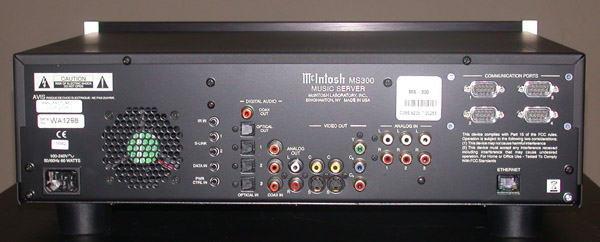Introduction
It seems now more than ever the world is inundated with buzzwords and catch
phrases. Watch any TV show or listen in on a business conference call, and
you will hear terms being thrown about that sound impressive at first blush
but lose any meaning upon closer examination.
Convergence is one of those
words that has been around for some time but has yet to resonate with me. It
always seemed a bit empty until I heard that McIntosh, a company basking in
the old world audio glow of tubes and Middle Age Teutonic lettering, had
released of all things a music server.
With over 55 years entrenched in the realm of high-end audio, McIntosh is
carefully dipping its toes into the ever expanding music server market. For
a company as steeped in the tradition of audio's past, I was impressed with
their foresight to release a product that embraces audio's future, which in
my estimation is music on demand.
Of course, I held out the hope that in this
look to the future they would not forget the roots of their success, namely
high performance, rock solid operation, and drop dead looks. With my interest
piqued, I inquired about a review sample and was promptly rewarded with a
well boxed package at my doorstep.
A Computer in Hi-Fi Clothing
While the MS300 façade owes its looks to the McIntosh designs of yore, the
technology packed behind that glossy veneer is quite formidable. Unlike many
of its competitors, which are essentially based on a modified PC
architecture, the MS300's hardware package, in the words of the designer, is
"custom designed around a set-top-box architecture specifically for this
application."
The application in this case is McIntosh's music server
interface which is based on the VXworks operating system, albeit a modified
version. Since the MS300 does not have a PC architecture, its specs are a bit
different than what you would expect, but housed within the chassis lurks an
IBM Power PC processor running at 266 MHz. Supporting the Power PC chip is
64 MB of RAM running at 133 MHz.
Audio is handled by what McIntosh calls a "24bit/96kHz high performance audio codec with switched capacitor filtering
for low noise". All DSP is handled by a Texas Instruments chipset. As
opposed to having a separate video card, the MS300's graphical user interface
is integrated and displayed via the Power PC chipset. All data are stored on
a Maxtor DiamondMax 10 300 GB parallel ATA drive.
While these specs pale compared to what is currently available in the PC
market, I never felt as if the system was overwhelmed. Tasks such as menu
navigation, creation of playlists, and track retrieval were all handled in a
timely manner. Since the OS/hardware was designed for this specific purpose,
the MS300 operates well within its capabilities, so do not fall into the trap
of spec envy.
The back panel of the MS300 is well populated and accommodates nearly any
connection scenario you could dream up. Since the quantity/type of
connections would overwhelm this review, I will simply focus on the more
interesting additions/omissions that separate the MS300 from the pack.

Of note was the plethora of RS-232 ports, a total of
four, the unit provides.
Should the substantial 300 GB drive included be unable to hold your
collection, McIntosh included the ability for the MS300 to control and manage
up to three external CD mega-changers via three of the available ports. Be warned
however, the MS300 favors brand loyalty, as all connected changers must be
from the same manufacturer. When you consider the MS300 can hold between
700-850 CDs losslessly, the addition of the changer control brings the
potential music archive to a whopping 2050 albums bit for bit identical to
the source. For those lucky few out there, the fourth port can be used to
connect the MS300 to a Crestron or AMX control system. The thought of having
my entire CD collection displayed and controlled via a 10" touch screen
nearly brought a tear to my eye. I am just relieved our own Colin Miller did
not conduct the review, as he would have been entranced by the control
possibilities the MS300 offers.
Click Here to Go to Part II.